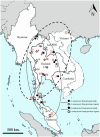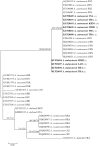Angiostrongylus cantonensis and A. malaysiensis Broadly Overlap in Thailand, Lao PDR, Cambodia and Myanmar: A Molecular Survey of Larvae in Land Snails
- PMID: 27513930
- PMCID: PMC4981448
- DOI: 10.1371/journal.pone.0161128
Angiostrongylus cantonensis and A. malaysiensis Broadly Overlap in Thailand, Lao PDR, Cambodia and Myanmar: A Molecular Survey of Larvae in Land Snails
Abstract
Angiostrongylus cantonensis is a zoonotic nematode parasite causing human eosinophilic meningitis (or meningoencephalitis) worldwide. A closely related species, Angiostrongylus malaysiensis, might also be a human pathogen. Larvae were obtained from land snails in Lao PDR, Cambodia, Myanmar and Thailand. We sequenced two nuclear gene regions (nuclear ribosomal ITS2 and SSU rRNA) and a portion of one mitochondrial gene (COI) from these larvae. Angiostrongylus cantonensis and A. malaysiensis were identified. This is the first report of the molecular identification of the two Angiostrongylus species in Lao PDR, Cambodia and Myanmar. The regional distributions of the two species broadly overlap. Phylogenetic relationships were inferred including data from Angiostrongylus species deposited in public databases. All the gene regions we sequenced have potential value in distinguishing between species of Angiostrongylus. The COI gene exhibited the greatest intraspecific variation in the study region (five haplotypes in A. cantonensis and four in A. malaysiensis) and might be suitable for more detailed phylogeographic studies.
Conflict of interest statement
Figures




References
-
- Tsai HC, Liu YC, Kunin CM, Lee SS, Chen YS, Lin HH, et al. Eosinophilic meningitis caused by Angiostrongylus cantonensis: report of 17 cases. Am J Med. 2001; 111: 109–114. - PubMed
MeSH terms
Substances
Supplementary concepts
LinkOut - more resources
Full Text Sources
Other Literature Sources
Molecular Biology Databases

